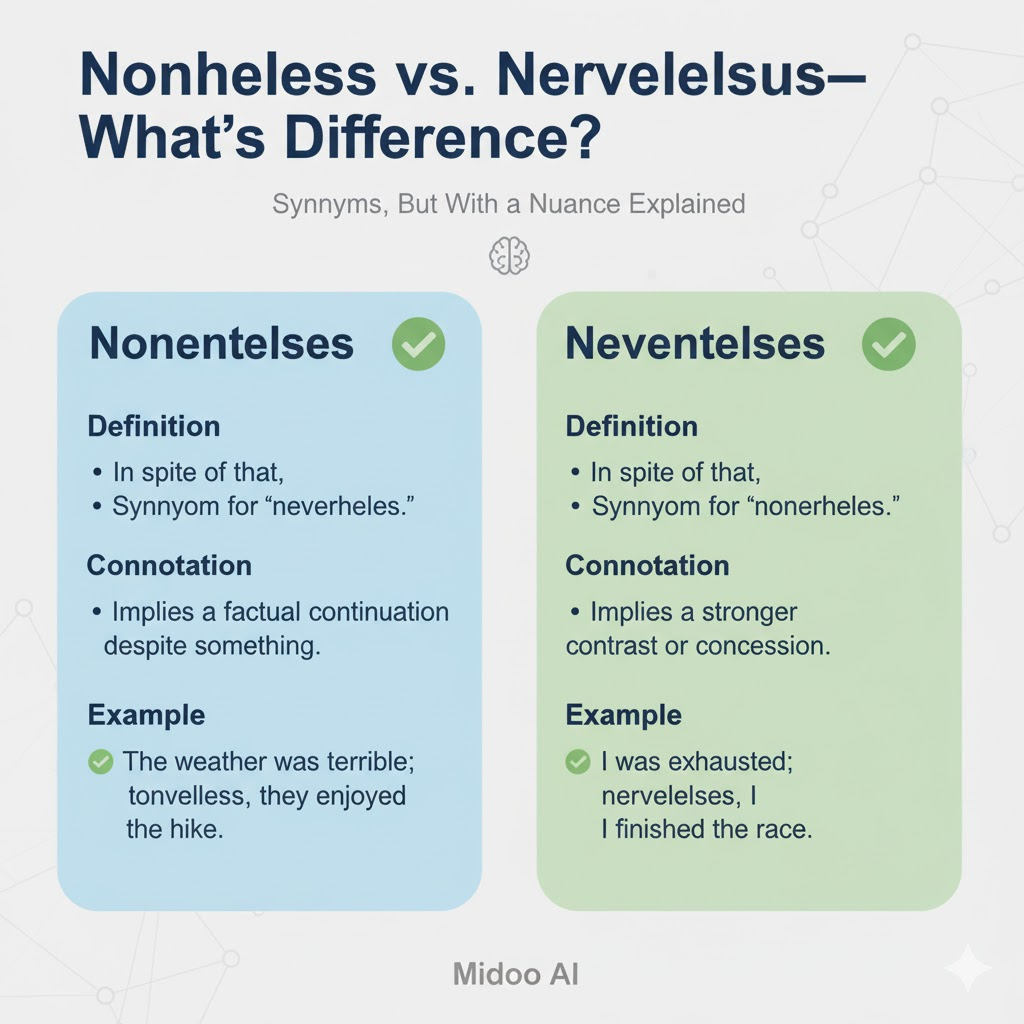Nonetheless vs. Nevertheless—What’s the Difference?

English learners often stumble when choosing between nonetheless and nevertheless—two words that look formal, sound similar, and often appear in the same contexts. So, are they interchangeable? Or is there a subtle difference between them?
At Midoo AI, we help you master these tricky word pairs so your writing sounds confident and natural. Let’s explore what sets nonetheless apart from nevertheless, when to use each, and how to remember them easily.
1. The Basic Meaning
Both nonetheless and nevertheless mean “in spite of that” or “even so.”
They are adverbs used to connect two contrasting ideas—much like “however” or “still.”
In most situations, you can use either word without changing the meaning.
✅ Examples:
- It was raining; nevertheless, we went hiking.
- She was tired; nonetheless, she continued studying.
- The task was challenging. Nevertheless, they succeeded.
- He didn’t get the promotion; nonetheless, he stayed positive.
Meaning: despite what was said before, the second action still happened.
2. Subtle Differences in Tone and Use
Even though they’re mostly interchangeable, nonetheless and nevertheless have slight stylistic differences:
| Aspect | Nonetheless | Nevertheless |
|---|---|---|
| Tone | Slightly more modern and conversational | Slightly more formal or traditional |
| Frequency | More common in everyday writing and speech | Common in formal writing or speeches |
| Length | Shorter and smoother | Longer and more emphatic |
✅ Examples:
- The film received poor reviews. Nonetheless, it attracted a huge audience.
→ smoother and slightly casual tone. - The company faced difficulties. Nevertheless, it achieved remarkable growth.
→ more formal and polished tone.
Tip: If you’re writing an academic essay, business report, or formal cover letter, nevertheless might sound more appropriate.
If you’re writing conversational English or storytelling, nonetheless feels more natural.
3. Sentence Placement
Both words are transition adverbs, so they usually appear:
- At the beginning of a sentence:
→ Nevertheless, she didn’t give up. - After a semicolon (;):
→ He failed the test; nonetheless, he stayed optimistic. - In the middle, after the subject:
→ She, nevertheless, decided to go.
However, starting the sentence with either is most common in modern English.
4. Common Mistakes to Avoid
❌ Incorrect: She didn’t like the offer, nevertheless she accepted it.
✅ Correct: She didn’t like the offer; nevertheless, she accepted it.
(Always separate with a semicolon or period when connecting clauses.)
❌ Incorrect: I was late but nonetheless I didn’t miss the train.
✅ Correct: I was late, but nonetheless, I didn’t miss the train.
(Add commas for smoother flow.)
5. Quick Comparison Table
| Usage Context | Correct Example | Recommended Word |
|---|---|---|
| Formal writing or reports | The results were disappointing; nevertheless, the study continued. | Nevertheless |
| Emails or blogs | It was expensive; nonetheless, worth every penny. | Nonetheless |
| Academic essays | The hypothesis failed; nevertheless, the data offered new insights. | Nevertheless |
| Daily conversation | I was tired; nonetheless, I went for a walk. | Nonetheless |
6. Easy Memory Tips
💡 Tip 1: Nonetheless = “not less,” so something still continues despite obstacles.
💡 Tip 2: Nevertheless = “never less,” so something never loses strength despite challenges.
💡 Tip 3: If you can replace it with “even so” or “despite that,” both are fine—choose based on tone.
✅ Example:
- “It was raining. Even so, we went hiking.”
→ You can replace even so with nonetheless or nevertheless easily.
7. Real-Life Examples
- Formal: The project faced multiple setbacks. Nevertheless, the team delivered on time.
- Conversational: I was nervous before the interview. Nonetheless, I did my best.
- Academic: The data contradicted the hypothesis; nevertheless, it provided valuable insights.
- Business: Sales dropped in Q1. Nonetheless, customer satisfaction improved.
FAQS
Q1: Can I always use “nonetheless” instead of “nevertheless”?
Almost always yes. Their meanings are nearly identical. The only difference is tone—nevertheless is slightly more formal.
Q2: Which one is more common in American English?
In American English, nonetheless is used more often in everyday contexts. Nevertheless appears more in formal writing or literature.
Q3: Can I start a sentence with “nevertheless”?
Absolutely. It’s grammatically correct and often used at the beginning of sentences to show contrast.
Q4: Are they used differently in British English?
Not significantly. Both are used in the U.K., though nevertheless may sound a bit more traditional.
Q5: What’s the simplest replacement for both?
Use “even so”, “still”, or “despite that” if you want more casual or simpler phrasing.